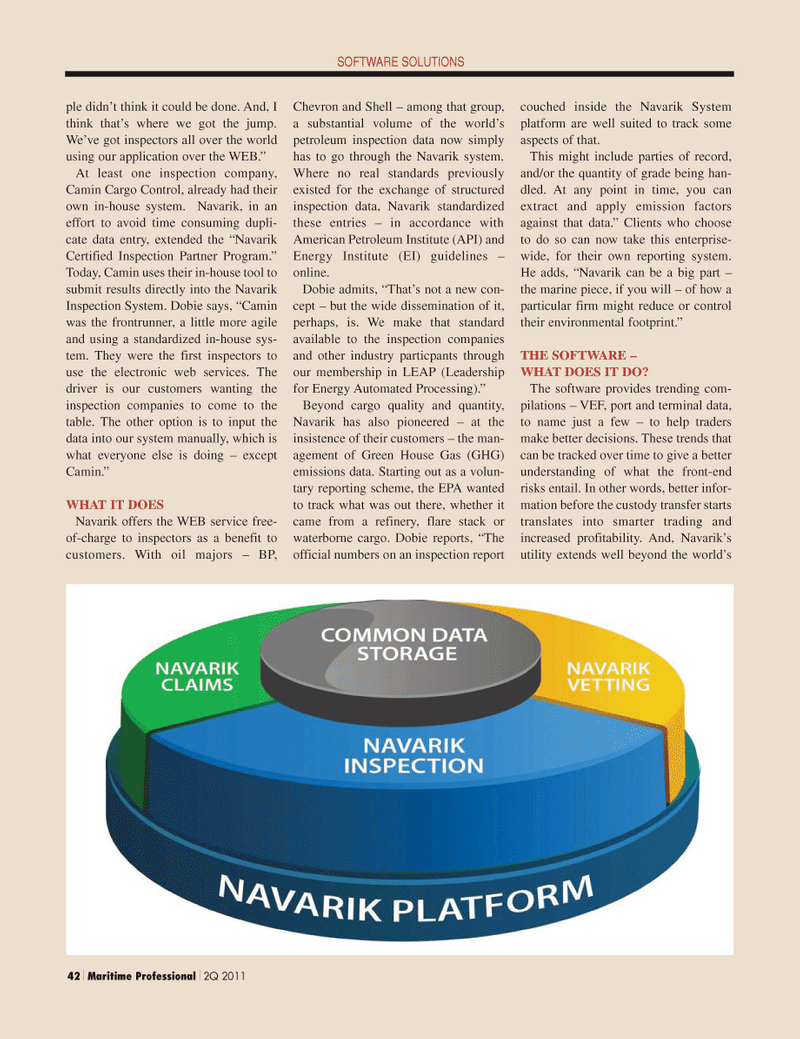
Page 42: of Maritime Logistics Professional Magazine (Q2 2011)
Energy Transportation
Read this page in Pdf, Flash or Html5 edition of Q2 2011 Maritime Logistics Professional Magazine
42 Maritime Professional 2Q 2011
SOFTWARE SOLUTIONS ple didn’t think it could be done. And, I think that’s where we got the jump.
We’ve got inspectors all over the world using our application over the WEB.”
At least one inspection company,
Camin Cargo Control, already had their own in-house system. Navarik, in an effort to avoid time consuming dupli- cate data entry, extended the “Navarik
Certified Inspection Partner Program.”
Today, Camin uses their in-house tool to submit results directly into the Navarik
Inspection System. Dobie says, “Camin was the frontrunner, a little more agile and using a standardized in-house sys- tem. They were the first inspectors to use the electronic web services. The driver is our customers wanting the inspection companies to come to the table. The other option is to input the data into our system manually, which is what everyone else is doing – except
Camin.”
WHAT IT DOES
Navarik offers the WEB service free- of-charge to inspectors as a benefit to customers. With oil majors – BP,
Chevron and Shell – among that group, a substantial volume of the world’s petroleum inspection data now simply has to go through the Navarik system.
Where no real standards previously existed for the exchange of structured inspection data, Navarik standardized these entries – in accordance with
American Petroleum Institute (API) and
Energy Institute (EI) guidelines – online.
Dobie admits, “That’s not a new con- cept – but the wide dissemination of it, perhaps, is. We make that standard available to the inspection companies and other industry particpants through our membership in LEAP (Leadership for Energy Automated Processing).”
Beyond cargo quality and quantity,
Navarik has also pioneered – at the insistence of their customers – the man- agement of Green House Gas (GHG) emissions data. Starting out as a volun- tary reporting scheme, the EPA wanted to track what was out there, whether it came from a refinery, flare stack or waterborne cargo. Dobie reports, “The official numbers on an inspection report couched inside the Navarik System platform are well suited to track some aspects of that.
This might include parties of record, and/or the quantity of grade being han- dled. At any point in time, you can extract and apply emission factors against that data.” Clients who choose to do so can now take this enterprise- wide, for their own reporting system.
He adds, “Navarik can be a big part – the marine piece, if you will – of how a particular firm might reduce or control their environmental footprint.”
THE SOFTWARE –
WHAT DOES IT DO?
The software provides trending com- pilations – VEF, port and terminal data, to name just a few – to help traders make better decisions. These trends that can be tracked over time to give a better understanding of what the front-end risks entail. In other words, better infor- mation before the custody transfer starts translates into smarter trading and increased profitability. And, Navarik’s utility extends well beyond the world’s

 41
41

 43
43
